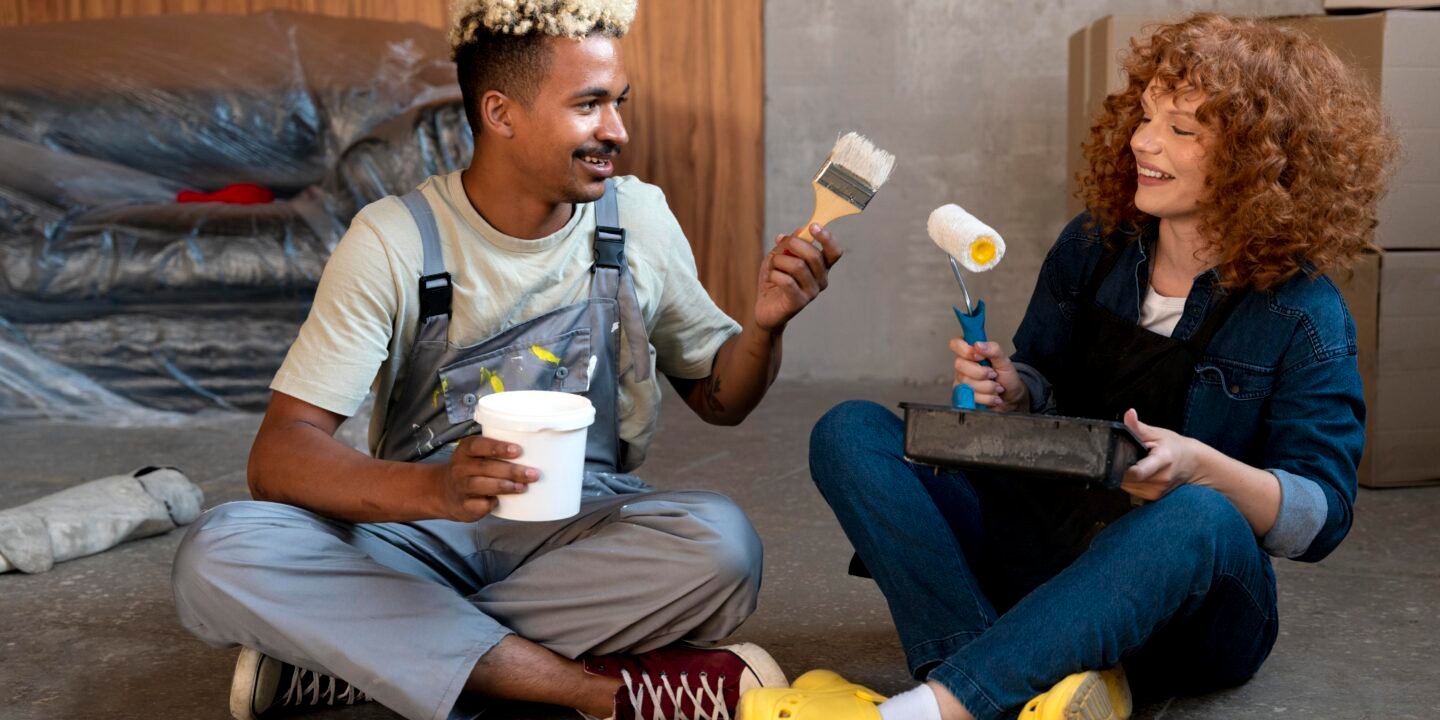
Home improvement projects can breathe new life into your space, making it more functional, beautiful, and enjoyable. Whether you’re a seasoned DIYer or just starting, there’s a project for everyone. From simple upgrades to more complex renovations, these ten essential DIY home improvement projects will help you transform your home without breaking the bank. Let’s dive into each project, complete with steps, tips, and ideas to get you started!
1. Fresh Coat of Paint
Overview
Painting is one of the most impactful ways to refresh your home. A new color can change the mood of a room, making it feel brighter, cozier, or more spacious.
Steps to Paint a Room
- Choose Your Color: Consider the room’s purpose and how you want it to feel. Use paint samples to test colors in different lighting.
- Gather Supplies: You’ll need paint, brushes, rollers, painter’s tape, drop cloths, and a ladder.
- Prepare the Room: Move furniture, cover it with drop cloths, and tape off edges and fixtures.
- Prime the Walls: If you’re making a drastic color change or painting new drywall, apply a primer first.
- Start Painting: Begin with the edges using a brush, then use a roller for larger areas. Apply a second coat if necessary.
- Clean Up: Remove the tape while the paint is still wet, clean your brushes, and replace furniture.
Tips
- Choose high-quality paint for better coverage and durability.
- Use low-VOC paint for a healthier indoor environment.
2. Upgrade Your Lighting
Overview
Updating light fixtures can dramatically change the ambiance of your space. This DIY project can be as simple as changing out lampshades or as involved as installing new fixtures.
Steps to Upgrade Lighting
- Assess Your Current Lighting: Determine which fixtures need replacing or upgrading.
- Choose New Fixtures: Select styles that match your decor. Consider LED options for energy efficiency.
- Turn Off Power: Ensure safety by turning off the power at the circuit breaker before starting any work.
- Remove Old Fixtures: Unscrew the existing fixtures and disconnect the wiring.
- Install New Fixtures: Follow the manufacturer’s instructions to connect and secure the new lighting.
- Restore Power: Turn the power back on and test your new lights.
Tips
- Layer your lighting with a mix of ambient, task, and accent lights.
- Consider dimmers for adjustable lighting options.
3. Create an Accent Wall
Overview
An accent wall can serve as a stunning focal point in any room. Whether you use paint, wallpaper, or wood, it’s a relatively simple project that adds character.
Steps to Create an Accent Wall
- Choose Your Wall: Select a wall that stands out, like one behind a bed or sofa.
- Select Your Material: Decide between paint, wallpaper, or wood paneling.
- Prepare the Wall: Clean the surface and fill any holes or imperfections.
- Apply the Chosen Material: If painting, tape off edges and apply a coat or two. For wallpaper, follow the manufacturer’s instructions. For wood, cut and attach planks to the wall.
- Finishing Touches: Add trim or moldings for a polished look.
Tips
- Use bold colors or patterns for a dramatic effect.
- Consider removable wallpaper for a non-permanent option.
4. Install a Backsplash
Overview
A kitchen backsplash not only protects walls from splashes but also adds style. This DIY project can be done with tiles, peel-and-stick materials, or even beadboard.
Steps to Install a Backsplash
- Choose Your Material: Select tiles, peel-and-stick panels, or beadboard that complements your kitchen decor.
- Measure the Area: Determine how much material you’ll need and purchase extra for mistakes.
- Prepare the Surface: Clean the wall surface thoroughly and remove any old adhesive or grime.
- Apply Adhesive: For tiles, use thin-set mortar. For peel-and-stick, simply peel and apply.
- Place Tiles or Panels: Start at the center and work outward, using spacers for even spacing. Cut tiles as needed.
- Grout and Seal: If using tiles, apply grout and allow it to cure. Seal the grout for added protection.
Tips
- Use a level to ensure your tiles are straight.
- Choose a grout color that enhances your tiles.
5. Build a Simple Shelving Unit
Overview
Shelves can provide additional storage and display space, making them a practical and stylish addition to any room.
Steps to Build Shelves
- Determine Your Needs: Decide how many shelves you want and where they will go.
- Gather Materials: You’ll need wood for the shelves, brackets, screws, and a drill.
- Measure and Cut Wood: Measure the desired length of your shelves and cut the wood accordingly.
- Install Brackets: Attach brackets to the wall using a level to ensure they’re straight.
- Place the Shelves: Lay the cut wood on top of the brackets and secure if necessary.
Tips
- Stain or paint the shelves to match your decor.
- Consider adding decorative brackets for extra style.
6. Replace Cabinet Hardware
Overview
Swapping out cabinet knobs and pulls is a quick and inexpensive way to update your kitchen or bathroom.
Steps to Replace Cabinet Hardware
- Choose New Hardware: Select styles and finishes that complement your decor.
- Remove Old Hardware: Unscrew existing knobs and pulls from cabinets and drawers.
- Position New Hardware: If the new hardware has different screw placements, fill old holes with wood filler and let dry.
- Attach New Hardware: Secure the new knobs or pulls using a screwdriver.
Tips
- Mix and match hardware for a unique look.
- Consider using knobs on drawers and pulls on cabinets for contrast.
7. Create Outdoor Spaces
Overview
Improving your outdoor areas can enhance your home’s curb appeal and create enjoyable spaces for relaxation or entertaining.
Steps to Create Outdoor Spaces
- Assess Your Yard: Determine how you want to use the space—dining, lounging, or gardening.
- Choose Your Features: Consider adding a patio, fire pit, or garden beds.
- Prepare the Area: Clear any debris and level the ground if necessary.
- Install Features: For a patio, lay pavers or stones. For a fire pit, follow a DIY guide to build it safely.
- Add Decor: Incorporate outdoor furniture, lighting, and plants to enhance the space.
Tips
- Use weather-resistant materials for durability.
- Create shaded areas with umbrellas or pergolas for comfort.
8. Upgrade Insulation
Overview
Improving your home’s insulation can enhance energy efficiency and comfort. This project can save you money on heating and cooling bills.
Steps to Upgrade Insulation
- Identify Areas Needing Insulation: Check attics, basements, and walls for gaps or inadequate insulation.
- Gather Materials: Choose insulation material based on your needs—batts, blown-in, or spray foam.
- Prepare the Space: Clear any debris and ensure proper ventilation.
- Install Insulation: Follow the manufacturer’s instructions for installation. Ensure there are no gaps for maximum effectiveness.
- Seal Air Leaks: Use caulk or foam to seal gaps around windows, doors, and vents.
Tips
- Consider hiring a professional for blown-in insulation.
- Use safety gear when handling insulation materials.
9. Revamp Flooring
Overview
Updating your flooring can completely change the look and feel of a room. Whether you choose to install laminate, vinyl, or tiles, the options are endless.
Steps to Revamp Flooring
- Choose Your Flooring: Select a material that suits your lifestyle and budget.
- Gather Tools and Materials: Ensure you have the necessary tools—cutting tools, adhesive, and spacers.
- Remove Old Flooring: Carefully take out the existing flooring and prepare the subfloor.
- Install New Flooring: Follow the manufacturer’s instructions for installation, ensuring you maintain even spacing and alignment.
- Finish Edges: Use trim or molding to finish edges and cover gaps.
Tips
- Consider DIY-friendly materials like laminate or vinyl for easier installation.
- Rent tools if you don’t have them to save on costs.
10. Enhance Curb Appeal
Overview
Improving your home’s exterior can increase its value and create a welcoming atmosphere. Simple changes can make a big difference.
Steps to Enhance Curb Appeal
- Landscape Your Yard: Add flowers, shrubs, or trees to improve the front yard’s aesthetics.
- Paint the Front Door: A bold color can make a statement and draw attention to your home.
- Upgrade Outdoor Lighting: Install new fixtures or solar lights to enhance safety and visibility.
- Clean Gutters and Siding: Regular maintenance improves the overall appearance and prevents damage.
- Add Outdoor Decor: Consider wreaths, planters, or decorative house numbers to enhance your home’s style.
Tips
- Use native plants for easier maintenance and better growth.
- Choose a cohesive color palette that complements your home’s architecture.
Final Thoughts
Embarking on DIY home improvement projects not only enhances the beauty and functionality of your space but also provides a sense of accomplishment. Whether you choose to paint a room, install new lighting, or tackle more complex renovations, there’s a project suited for every skill level. By investing time and effort into your home, you’ll create a space that reflects your personality and meets your needs. So roll up your sleeves, gather your materials, and start transforming your home today! Happy DIYing!








